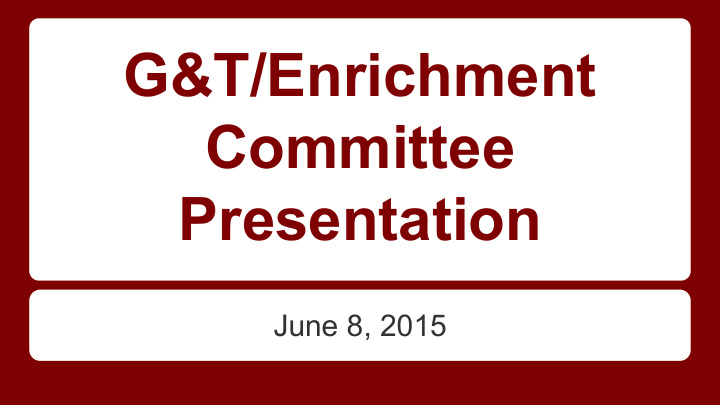



G&T/Enrichment Committee Presentation June 8, 2015
G&T/Enrichment Committee Members Administrators Elementary Teachers Secondary Teachers ● Karen Jones (CO) ● Stephanie Ambrose (ST) ● Jesse Johnson (MAMS) ● John Bombardier (CO) ● Adrienne Scheuing (ST) ● Amy Raiola (MAMS) ● Pat Janover (RD) ● Christina Kushwara (ST) ● Sean Cronin (MAMS) ● Kelly Bera (ST) ● Joann Hickey (CL) ● Zachary Gross (HS) ● Valerie Ulrich (CL) ● Jill Donovan (RD) ● Maria McDede (HS) ● Joe Jerabek (LR) ● Lori Thomson (RD) ● Mona Tobia (LR) ● Paula Murray (RD) District Coaches ● Cory Radisch (MAMS) ● Sue Serden (LR) ● Raquel Colao (Literacy) ● Mark Van Horn (MAMS) ● Amy Mammano (LR) ● Lauren Berman (Literacy) ● Michele Ruscavage (HS) ● Mark Irons (Technology)
Research The research committee has reviewed numerous articles and reports, and has reached out to other school districts to develop a program that will meet the needs of the students in the Matawan-Aberdeen Regional School District. The following slides illustrate the findings of our committee and the recommendations we are making.
Why Should We Identify Exceptional Students? To provide students with learning opportunities to meet individual needs through differentiation, acceleration, rigor, and choice.
What Does Gifted & Talented Mean? NJ regulations define G&T students as: Those students who possess or demonstrate high levels of ability, in one or more content areas, when compared to their chronological peers in the local district and who require modification of their educational program if they are to achieve in accordance with their capabilities (NJAC 6A: 8-3.1).
Researched Best Practice for G&T/Enrichment
Current MARSD Data for Grades 3 - 8
Data Comparison Researched Best Current MARSD Data Practice
What Models Exist for G&T and Enrichment? ● Programs are designed in various ways to meet students’ needs. These include: ○ Self-contained classes ○ Pull-out programs ○ Push-in programs ● In Monmouth County, the large majority of districts utilize a pull-out model for Enrichment.
PEP Personal Excellence Program K-5 Tier 1 Tier 2 Tier 3 Full Implementation: 2016-2017
Grouping Methods ● Tier 1: Self-contained (Grades 3-5) ● Tier 2: “Cluster” groupings of Enrichment level students dispersed into heterogeneous classes.These Enrichment “clusters” receive additional learning opportunities (Grades 2-5) ● Tier 3: Enrichment for all students
Tier 1: Self Contained Grades 3-5 ● The highest and most rigorously designed tier which services the top 1-5% of district students in grades 3-5 ■ 1 self-contained class per grade level district-wide ■ Students must meet all elements of set criteria in BOTH language arts and math ■ Student performance is continuously monitored and assessed throughout the program
Tier 2: Cluster Placement Program ● This model services the academic needs of high achieving students in grades 2-5 who meet the criteria for Tier 2 Cluster Placement ■ This model is implemented in all four elementary schools Students are pre-identified based on criteria and placed in a math and/or ■ language arts cluster groups within heterogeneous classrooms ■ Classroom teachers provide cluster students within-class enrichment opportunities to extend their learning and build their critical thinking skills ■ Resource specialists work to support teachers and provide additional opportunities for students to go beyond the curriculum
Tier 3: Enrichment Program Enrichment opportunities for all students. ● This model benefits students’ learning by providing time to ■ come together with peers of similar ability or interest to engage in authentic, real-life learning experiences May include before/after school clubs and school-wide ■ programs/assemblies ■ Resource specialist will be a resource for teachers in grades K-5
K-5 Criteria for Gifted & Talented Identification ● Teacher observation rating tool ● District-wide norm referenced test ● DRA-2 (Developmental Reading Assessment) ● Student interview (K-1) ● Norm-Referenced (standardized) screening assessment ● District assessments
Current Offerings MAMS MRHS Honors & Advanced Honors Academies Accelerated Placement ELA and Math Criteria includes multiple measures: Criteria include: Grades, Normed-Referenced Test Grades, Teacher Recommendation, (NWEA), Work Habits / Study Skills Additional requirements for Rubric, DRA2, final exams, QM scores, Academies (Application Essay & math benchmarks OLSAT)
MAMS PRIDE PROGRAM P ersonal R esponsibility I n D elivering E xcellence
Five Options to Show PRIDE 1.) Future Problem Solving (FPS) 2.) Scenario Writing (A branch of the FPS) 3.) National History Day (NHD) 4.) Passion Project (Inquiry Based) 5.) Robotics (FIRST) *These programs can be matriculated up to the high school through existing clubs and activities
What Should You Expect in 2015- 2016? ■ Grades 3-5 will remain in a self-contained homeroom. ■ Tier 2: Cluster Groups - Grade 2 & Gr. 4-5 ■ Tier 3: K-5 Enrichment Opportunities ■ Dedicated Resource Specialist, K-2 ■ Teacher professional development for Tier 2 cluster groups
Next Steps ■ Forming building-level committees ■ Exploring new course offerings/academies for high school ■ Selecting screening tools and finalizing criteria ■ Exploring feasibility of PRIDE program at middle school ■ Explore self-contained 3rd grade in one location for 16-17 school year
Questions?
Recommend
More recommend